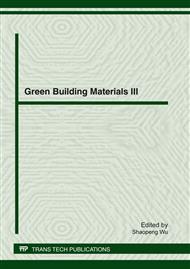p.119
p.123
p.128
p.136
p.142
p.149
p.155
p.162
p.168
Mechanical Properties of Asphalt Mixture Reinforced with Cellulose-Polyester Hybrid Fibers
Abstract:
With regards of discussing cellulose and polyester fibers reinforced asphalt mixtures, the contribution of cellulose (CEL) and polyester (PET) fibers had therefore been experimented. And on the basis of different reinforcement mechanisms, this research focused on the cellulose (CEL) - polyester (PET) hybrid fibers reinforced system, consequently determined the feasibility of utilizing CEL-PET hybrid fibers in asphalt mixture. Asphalt mixtures had been prepared, according to the specifications, following both the SHRP procedure and the traditional one. Mechanical characteristics of the mixtures were evaluated with Marshall stability (MS), indirect tensile strength (ITS), moisture sensitivity, high temperature rutting test and fatigue test. This study compared the performance of mixtures containing hybrid fibers with mixes made with and without commonly used cellulose and polyester fibers produced specifically for use in hot mix asphalt (HMA). The research results showed that no significant differences in MS, ITS or moisture susceptibility were found in mixtures containing hybrid fibers compared to cellulose or polyester. Also, the hybrid fibers significantly improved the permanent deformation resistance of the mixtures compared to cellulose fibers, say nothing of the control one without fibers.
Info:
Periodical:
Pages:
142-148
Citation:
Online since:
April 2012
Authors:
Keywords:
Price:
Сopyright:
© 2012 Trans Tech Publications Ltd. All Rights Reserved
Share:
Citation:


